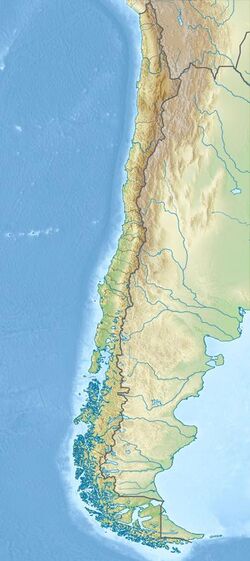Earth:Chilean Iron Belt
| Chilean Iron Belt Stratigraphic range: Cretaceous ~132–84 Ma | |
|---|---|
| Type | Mining district |
| Location | |
| Coordinates | [ ⚑ ] : 27°21′59″S 70°25′59″W / 27.366389°S 70.433056°W |
| Region | Atacama Region, Coquimbo Region |
| Country | Chile |
| Extent | Atacama Fault System |
The Chilean Iron Belt is a geological province rich in iron ore deposits in northern Chile. It extends as a north-south beld along the western part of the Chilean regions of Coquimbo and Atacama, chiefly between the cities of La Serena and Taltal.[1][2] The belt follows much of the Atacama Fault System and is about 600 km long and 25 km broad.[2][3]
Iron oxide-apatite, iron oxide copper gold ore deposits (IOCG) and manto-type copper and silver are the main types of deposits.[1][2] Iron-apatite and IOCG are considered to have different origins.[4] Manto-type deposits are concentrated in the northern part of the belt and are chiefly emplaced on rocks of La Negra Formation.[1]
The ores of the Chilean Iron Belt formed in separate pulses in the Cretaceous period as result of magmatic and hydrothermal processes.[1] At least part of the iron oxide-apatite rock originated from molten iron in the form of lava, tephra.[3] and intrusions.[4] Thus iron oxide apatite magma cooled into rock variously from surface volcanoes to depths of 10 km over even more.[4]
Some geologists have speculated that a large meteorite impact in the Pacific during the Cretaceous period may have set in motion a series of tectonic changes that led to the formation the ores.[5]
Iron mines along the Chilean Iron Belt
- El Carmen
- Los Colorados
- El Algarrobo
- El Tofo (defunct)
- El Romeral
References
- ↑ Jump up to: 1.0 1.1 1.2 1.3 Barra, Fernando; Reich, M.; Selby, D.; Rojas, P.; Simon, A.; Salazar, E.; Palma, G. (2017). "Unraveling the origin of the Andean IOCG clan: a Re-Os isotope approach". Ore Geology Reviews 81 (1): 62–78. doi:10.1016/j.oregeorev.2016.10.016. Bibcode: 2017OGRv...81...62B. https://dro.dur.ac.uk/20115/1/20115.pdf.
- ↑ Jump up to: 2.0 2.1 2.2 Simon, Adam C.; Knipping, Jaayne; Reich, Martin; Barra, Fernando; Deditius, Artur P.; Bilenker, Laura; Childress, Tristan (2018). "Kiruna-Type Iron Oxide-Apatite (IOA) and Iron Oxide Copper-Gold (IOCG) Deposits Form by a Combination of Igneous and Magmatic-Hydrothermal Processes: Evidence from the Chilean Iron Belt". in Arribas R., Antonio M.. Metals, Minerals, and Society. Society of Economic Geologists Special Publication. 21. pp. 89–114. doi:10.5382/SP.21. ISBN 9781629493084.
- ↑ Jump up to: 3.0 3.1 Travisany, Vinicio; Henríquez, Fernando; Nyström, Jan Olov (1995). "Magnetite lava flows in the Pleito-Melon District of the Chilean iron belt". Economic Geology 90 (2): 438–444. doi:10.2113/gsecongeo.90.2.438. Bibcode: 1995EcGeo..90..438T.
- ↑ Jump up to: 4.0 4.1 4.2 Tornos, Fernando; Hanchar, John M.; Munizaga, Rodrigo; Velasco, Francisco; Galindo, Carmen (2020). "The role of the subducting slab and melt crystallization in the formation of magnetite-(apatite) systems, Coastal Cordillera of Chile". Mineralium Deposita 56 (2): 253–278. doi:10.1007/s00126-020-00959-9.
- ↑ Oyarzún, J.; Oyarzun, R.; Lillo, J.; Ménard, J.J. (2012). "May a large asteroid impact in the Pacific have triggered a cascade of tectonomagmatic events leading to formation of the Mid-Cretaceous Chilean Iron Belt?". Geotemas 13: 1915–1918. https://dialnet.unirioja.es/servlet/articulo?codigo=8214048.
 |


